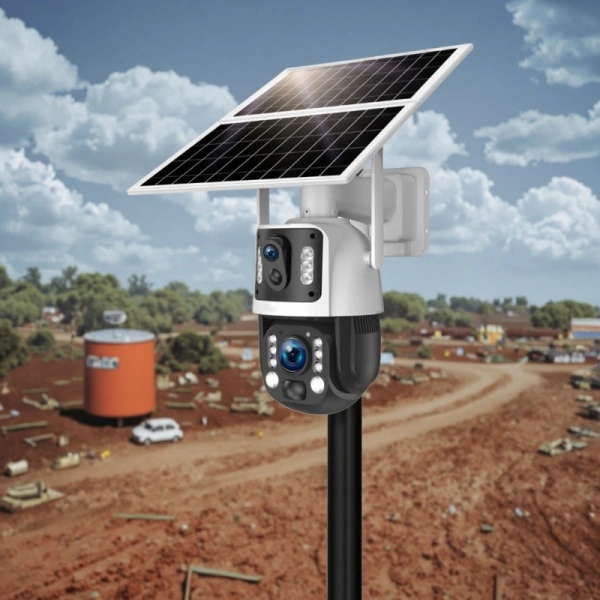History and Origin of Solar-Powered Security Cameras
The invention of the solar-powered security camera wasn’t a single event. Instead, it was the result of two separate technological paths—security surveillance and solar photovoltaics—converging over time due to specific market needs.
We can break down its history into three main phases:
Phase 1: The Foundational Era (Mid-20th to Late 20th Century)
During this period, security cameras and solar power developed independently, laying the groundwork for their future integration.
1. The Evolution of Security Cameras (CCTV):
- Origins (1940s): The first closed-circuit television (CCTV) system was developed in Germany in 1942 to observe V-2 rocket launches. These systems were enormous, extremely expensive, and completely dependent on wired power and video cables.
- Commercialization (1960s-1980s): CCTV began to be used for security in high-value locations like banks and retail stores. The equipment remained bulky and required professional installation of both power lines and coaxial video cables, making it costly.
- Digitalization & Networking (1990s): The invention of the IP (Internet Protocol) camera was a major milestone. It digitized the video signal and sent it over computer networks, eliminating the need for dedicated video cables. Concurrently, the development of CMOS image sensors started to significantly reduce the power consumption of cameras.
2. The Evolution of Solar (Photovoltaic) Technology:
- Scientific Discovery (1839): French physicist Edmond Becquerel discovered the photovoltaic effect, the underlying principle of solar cells.
- Practical Birth (1954): Bell Labs in the United States created the first practical silicon solar cell.
- Early Applications (1950s-1970s): Due to its immense cost, solar technology was initially used almost exclusively in the aerospace industry to power satellites (like the Vanguard 1 in 1958). On Earth, it was seen as a technology for the distant future.
- Cost Reduction (1980s-Present): Thanks to technological advancements and mass production, the cost of solar panels began to drop dramatically while their efficiency increased, making terrestrial applications economically viable.
Summary of this phase: The necessary conditions for a merger were forming. Cameras were becoming smaller, more power-efficient, and network-ready, while solar power was becoming cheaper and more effective.
Phase 2: Convergence and Early Applications (Early 2000s)
As the new millennium began, the two technologies started to merge, driven by a clear need.
- Demand-Driven Innovation: The primary motivation came from locations where running power cables was difficult or prohibitively expensive. These included:
- Remote farms, ranches, and fish ponds.
- Construction sites and temporary event venues.
- Monitoring along infrastructure like highways, railways, and oil pipelines.
- Environmental monitoring and forest fire prevention.
In these scenarios, the cost of laying an electrical line could be thousands of dollars, far exceeding the value of the camera itself. Solar power became the only feasible solution.
- Early Product Form:
- “Assembled” Solutions: The first solar security systems were not integrated products. They were typically custom solutions put together by security engineers, combining an IP camera, a solar panel, a charge controller, and a bulky lead-acid battery.
- High Cost & Professional Niche: These systems were large, expensive, and complex to install, limiting their use to government projects and large corporations. They were not consumer products.
- Key Bottlenecks: Power consumption and data transmission were the two biggest challenges. Cameras were still relatively power-hungry, requiring large panels and batteries to last through cloudy days. Data was transmitted over nascent 3G networks, which had high data costs.
Phase 3: All-in-One Integration and Mass Adoption (2010s to Present)
This is the era when the solar-powered security camera truly matured and became a mainstream product, thanks to several key technological breakthroughs:
- Low-Power Technology: Camera chips (SoCs) became incredibly energy-efficient, enabling an ultra-low power standby mode. The camera would only “wake up” and record when motion was detected, drastically conserving energy.
- Lithium Battery Technology: High-energy-density lithium batteries replaced heavy, bulky lead-acid batteries. This allowed the entire system to be designed to be much more compact and lightweight.
- 4G/5G Network Proliferation: Mobile networks became faster, more widespread, and more affordable, solving the data transmission bottleneck. Users could now view live footage from their smartphones anywhere, anytime.
- All-in-One Design: Manufacturers began integrating the camera, solar panel, battery, and 4G module into a single, compact housing. This “All-in-One” design made installation incredibly simple, allowing for easy DIY setup.
- AI-Powered Analytics: The addition of AI chips allowed cameras to perform analysis on the device itself (“at the edge”). They could distinguish between people and vehicles, filtering out false alarms from wind, rain, or small animals. This further reduced unnecessary “wake-ups” and saved even more power.
The Solar Camera of Today:
Modern solar-powered security cameras, like the one in the image you provided, are highly integrated, user-friendly, and affordable consumer products. They have solved the ultimate surveillance challenge of “no power, no problem,” becoming a popular security solution for backyards, farms, construction sites, and any off-grid location.
In summary, the history of the solar-powered security camera is a journey from a “professional, bulky, and expensive” assembled system to a “smart, compact, and accessible” all-in-one product, driven by market demand and waves of innovation in mobile networking, low-power chips, and battery technology.

